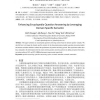ACL
2001
14 years 27 days ago
2001
ACL
2003
14 years 27 days ago
2003
This paper proposes the “Hierarchical Directed Acyclic Graph (HDAG) Kernel” for structured natural language data. The HDAG Kernel directly accepts several levels of both chunk...
ACL
2001
14 years 27 days ago
2001
Techniques for automatically training modules of a natural language generator have recently been proposed, but a fundamental concern is whether the quality of utterances produced ...
ACL
2003
14 years 27 days ago
2003
In this paper we present a novel, customizable IE paradigm that takes advantage of predicate-argument structures. We also introduce a new way of automatically identifying predicat...
ACL
2001
14 years 27 days ago
2001
Considering the difficulties inherent in the manual construction of natural language parsers, we have designed and implemented our system GRIND which is capable of learning a sequ...
ACL
2003
14 years 27 days ago
2003
Several approaches have been described for the automatic unsupervised acquisition of patterns for information extraction. Each approach is based on a particular model for the patt...
ACL
2003
14 years 27 days ago
2003
We apply a decision tree based approach to pronoun resolution in spoken dialogue. Our system deals with pronouns with NPand non-NP-antecedents. We present a set of features design...
ACL
2001
14 years 27 days ago
2001
We present a set of algorithms that enable us to translate natural language sentences by exploiting both a translation memory and a statistical-based translation model. Our result...
ACL
2003
14 years 27 days ago
2003
Automatically acquiring synonymous collocation pairs such as <turn on, OBJ, light> and <switch on, OBJ, light> from corpora is a challenging task. For this task, we ca...
ACL
2003
14 years 27 days ago
2003
The paper describes two parsing schemes: a shallow approach based on machine learning and a cascaded finite-state parser with a hand-crafted grammar. It discusses several ways to...

